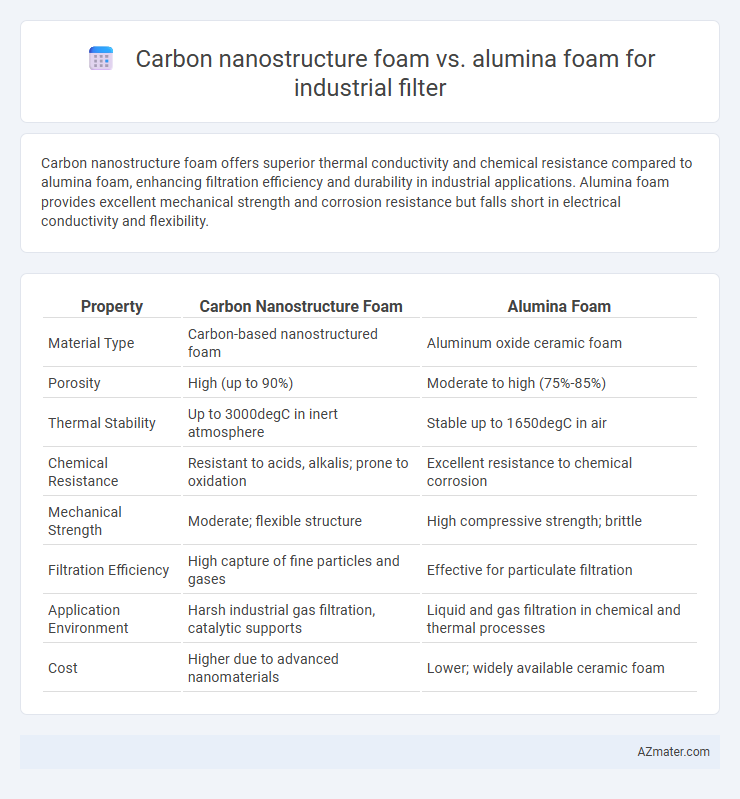Carbon nanostructure foam offers superior thermal conductivity and chemical resistance compared to alumina foam, enhancing filtration efficiency and durability in industrial applications. Alumina foam provides excellent mechanical strength and corrosion resistance but falls short in electrical conductivity and flexibility.
Table of Comparison
| Property | Carbon Nanostructure Foam | Alumina Foam |
|---|---|---|
| Material Type | Carbon-based nanostructured foam | Aluminum oxide ceramic foam |
| Porosity | High (up to 90%) | Moderate to high (75%-85%) |
| Thermal Stability | Up to 3000degC in inert atmosphere | Stable up to 1650degC in air |
| Chemical Resistance | Resistant to acids, alkalis; prone to oxidation | Excellent resistance to chemical corrosion |
| Mechanical Strength | Moderate; flexible structure | High compressive strength; brittle |
| Filtration Efficiency | High capture of fine particles and gases | Effective for particulate filtration |
| Application Environment | Harsh industrial gas filtration, catalytic supports | Liquid and gas filtration in chemical and thermal processes |
| Cost | Higher due to advanced nanomaterials | Lower; widely available ceramic foam |
Introduction to Industrial Filtration Materials
Carbon nanostructure foam offers exceptional chemical resistance and thermal stability, making it ideal for harsh industrial filtration environments where durability and contamination resistance are critical. Alumina foam provides high mechanical strength and excellent filtration efficiency at elevated temperatures, commonly used in industries requiring robust structural integrity and corrosion resistance. Selecting between carbon nanostructure and alumina foams depends on specific operational conditions such as temperature range, chemical exposure, and desired filtration precision.
Overview of Carbon Nanostructure Foam
Carbon nanostructure foam exhibits exceptional properties such as high surface area, thermal stability, and electrical conductivity, making it ideal for industrial filtration applications. Its porous morphology enables efficient filtration of fine particulates and gases, outperforming traditional Alumina foam in terms of adsorption capacity and resistance to chemical corrosion. The advanced carbon nanostructure foam enhances filter longevity and performance under high-temperature and harsh chemical environments commonly found in industrial processes.
Overview of Alumina Foam
Alumina foam, a porous ceramic material composed primarily of aluminum oxide, offers high thermal stability and excellent chemical resistance, making it ideal for industrial filtration applications in harsh environments. Its interconnected pore structure facilitates efficient fluid flow while trapping particulate contaminants, ensuring effective filtration performance. Compared to carbon nanostructure foam, alumina foam typically exhibits superior mechanical strength and durability under high-temperature conditions.
Comparative Porosity and Surface Area
Carbon nanostructure foam exhibits significantly higher porosity and larger specific surface area compared to alumina foam, enhancing its filtration efficiency in industrial applications. The nano-scale pore structure of carbon foam provides superior adsorption capabilities, enabling effective capture of fine particulates and gas molecules. In contrast, alumina foam, while offering good thermal stability and mechanical strength, typically has lower porosity and surface area, limiting its filtration performance for ultra-fine contaminants.
Thermal and Chemical Resistance Analysis
Carbon nanostructure foam exhibits superior thermal stability with operational temperatures exceeding 3000degC, compared to alumina foam's threshold around 1700degC, making it ideal for extreme thermal environments. Chemically, carbon foam resists acidic and basic corrosion more effectively due to its inert sp2-hybridized carbon bonds, while alumina foam is susceptible to alkaline degradation despite its robust acid resistance. This combination of high thermal tolerance and chemical resilience positions carbon nanostructure foam as a premium choice for demanding industrial filtration applications requiring long-term durability.
Mechanical Strength and Durability
Carbon nanostructure foam exhibits superior mechanical strength and durability compared to alumina foam, making it highly suitable for demanding industrial filtration applications. Its exceptional tensile strength and resistance to thermal shock enable prolonged performance under harsh chemical and temperature conditions. Alumina foam, while offering good thermal stability, generally falls short in impact resistance and mechanical robustness, leading to potential structural degradation over time.
Filtration Efficiency and Particle Removal
Carbon nanostructure foam offers superior filtration efficiency compared to alumina foam due to its high surface area and interconnected pore structure, which facilitates enhanced particle capture at the nanoscale. Alumina foam, while providing good mechanical strength and thermal stability, typically exhibits lower particle removal efficiency for fine particulates and ultrafine aerosols. The inherent electrical conductivity and chemical reactivity of carbon nanostructure foam also enable the adsorption of various contaminants, making it a preferred choice for industrial filtration applications requiring high-performance particle removal.
Cost-Effectiveness and Scalability
Carbon nanostructure foam offers superior cost-effectiveness for industrial filters due to its high durability and reusability, reducing long-term maintenance expenses compared to alumina foam. Scalability of carbon nanostructure foam production benefits from advanced manufacturing techniques such as chemical vapor deposition, enabling consistent quality at larger volumes. In contrast, alumina foam, while chemically stable and thermally resistant, faces higher production costs and limited scalability due to energy-intensive sintering processes.
Environmental Impact and Sustainability
Carbon nanostructure foam offers superior environmental benefits compared to alumina foam due to its higher recyclability and lower energy consumption during production, reducing overall carbon footprint in industrial filter applications. Its lightweight and porous architecture enable efficient filtration with less material usage, promoting sustainable resource management. Alumina foam, while durable, requires energy-intensive manufacturing and poses challenges in recycling, increasing environmental impact over its lifecycle.
Future Trends in Industrial Filter Technologies
Carbon nanostructure foam offers superior adsorption capabilities and thermal stability compared to Alumina foam, making it a promising material for next-generation industrial filters. Emerging trends highlight increased demand for lightweight, high-efficiency filters capable of operating in extreme environments, where carbon nanostructure foams excel due to their electrical conductivity and chemical resistance. Research focuses on enhancing pore architecture and functionalization of carbon nanostructure foams to improve contaminant removal and regeneration cycles, positioning them as a key advancement in sustainable filtration technologies.

Infographic: Carbon nanostructure foam vs Alumina foam for Industrial filter
 azmater.com
azmater.com